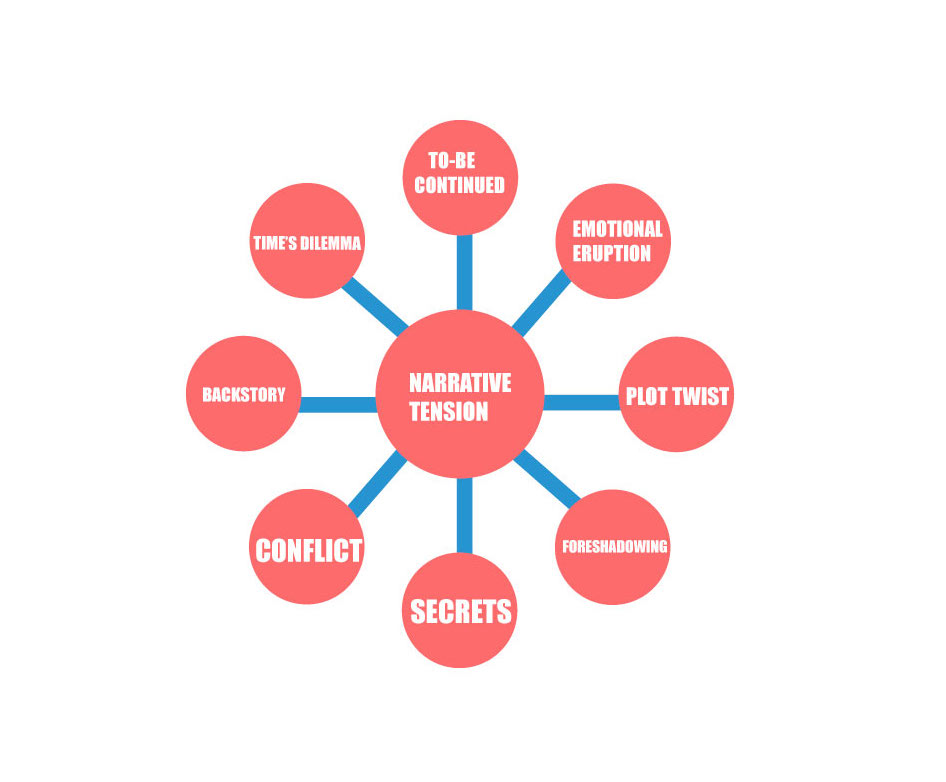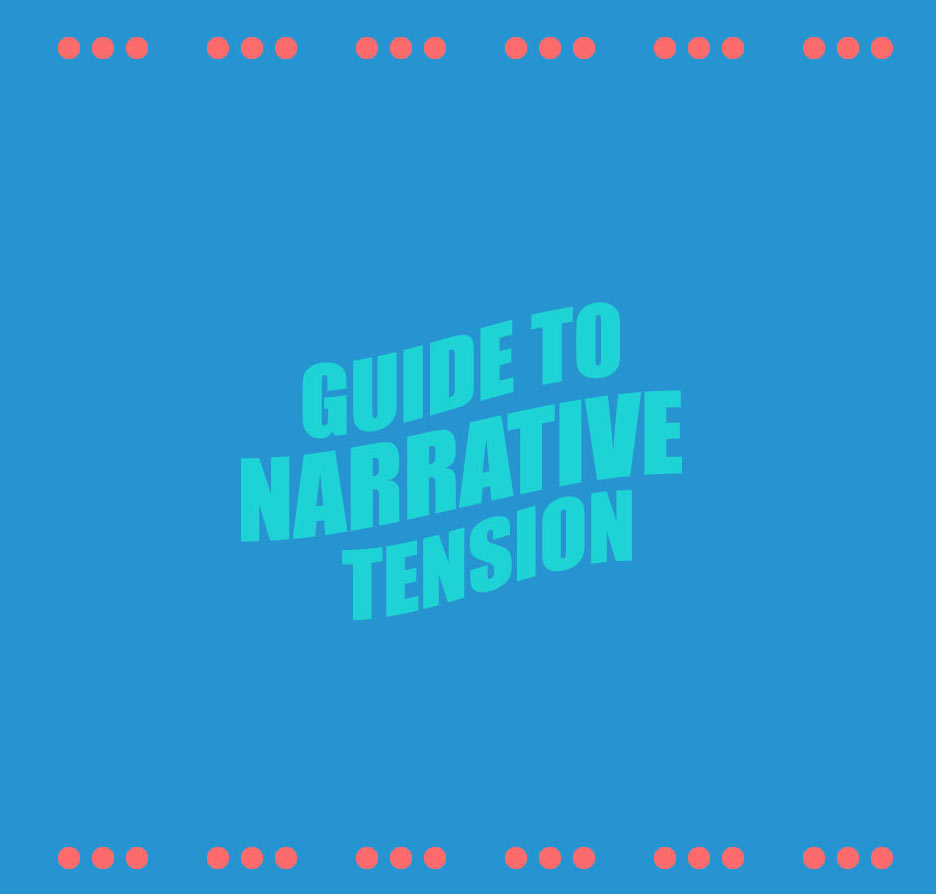How do you keep the readers interested in the long story you have written? How to keep the readers interested in the article that you are about to write? This interest is generated from a little element called narrative tension. Narrative tension means you structure the story in such a way that keeps the readers want to know “what happens next?”
There are videos on YouTube called “To be continued” videos where you see something dangerous is about to happen and then the video stops. No matter how busy you are, if you are given the next video that showed what happened next, you will click on it. This is narrative tension, not per se, but it has the essence of it.
You can write a great novel about complex characters, a brilliant plot, perfectly used imagery, and a satisfying climax. But all these elements are not present by the book itself. The readers have to go through the effort of reading the novel. Narrative tension is the fuel that keeps the readers’ hands turning the pages.
This element can be a challenging thing for new writers. First they have a story concept which must be stretched to make it a story. That’s not enough, without appropriate narrative tension, the book will never be read. The first ten pages and the readers give up.
This article will focus on the elements used to bring out narrative tension, the best way to employ this element in your work, and why it is needed in every written content. We’ll also look at the subtle differences between conflict, pacing, plot-twists, and narrative tension.
To make the article more lucid, I’ll introduce a character and a bit of his story that will be used along the lines of this article. How the elements that we discuss here affect the story of Mr. Mucklehead, the man who refused to bath.
No one knows why Mr. Mucklehead refuses to take a bath. This of course causes a lot of tension between him and his wife, Ms. Cleanworth. Arguments were a common thing. It was as if these two were the exact opposite of each other. But Mucklehead knew something. But he tried his best to keep it a secret. What was it? Why did he stay filthy? We shall find out. The secret he held brings us to the first point; secrets.
Secrets
A great way (and the most common one) to get a good amount of narrative tension in your story is by not revealing everything. But you may say, “Hey, we know that. That is the point of every story, to have one uncertain element that gets resolved in the end”.
That is true, but I am not talking about the terminal truth that is revealed in the climax of the story. I am talking about minor mysteries related to the ending of the novel that should be introduced and revealed frequently. This is what keeps the readers interested.
To get a better idea about it, look at the TV series that are served in short episodes. The final revelation comes in the season finale, but there are minor mysteries and revelation in many episodes. Readers must always seek an achievable goal that comes to them quickly, say after the end of chapter 2. Reading a 500-pages long book just for that one final revelation wouldn’t be worth it and frankly, really boring.
Note – This doesn’t mean every chapter of the book must have a secret related to the character or the sub-plot. This should happen frequently, not all the time. Give some pages for character and relationship development.
For example, the main character, or the side-characters are hiding something. Maybe some characters aren’t trustworthy, they act as if they are onto something. Maybe the place the protagonist has visited isn’t safe or maybe they have taken the wrong step.
Conflict
Conflict comes in a variety. There is an inner and external conflict. The conflict between the protagonist and the antagonist. Then there is a conflict between friends and lovers. Conflict keeps the interaction between people interesting. What would two people talk about if they agreed on everything? But bringing conflict is a difficult task. Let’s take a look at the types of conflict
Internal conflict – This is the conflict that arises when thoughts and actions of the characters don’t match. The protagonist does not want to do a particular thing, but the situation forces him/her to.
External conflict – It comes from the events of the outside world, the choices the characters have to make. Should Spiderman save a bus full of children or his sweetheart Mary Jane? What the hero will choose makes the readers interested and this is the goal.
The conflict between people – To make the characters much more interesting, there must be a conflict between them. Now don’t go and simply add contrasting mindsets just for the sake of conflict. The conflict should be reasonable. The readers must feel the tension. No matter whose side they take, they must see convincing reasons from both sides. Yes, even from the antagonist. Remember, the protagonist and antagonist are essentially two people looking at the same thing with different perspectives.
Mr. Mucklehead knew that things would turn out this way, he knew the cost he was going to pay for that. But Ms. Cleanworth took her stand. She never wanted to be a man that never bothers to clean himself. After all she was the epitome of cleanliness. And this was agreed by their neighbor, Mr. Pureshine. He saw each day how wrong Mr. Mucklehead was and felt sorry for Ms. Cleanworth. “Pureshine and Cleanworth, a match made in heaven”, he used to think…But how could he approach her, how could he ask her to leave this Mucklehead? He had no clue.
Related articles:
- How to use Five-step finale to make your story great.
- Use Prisoner’s constraint to improve writing.
- What’s in a feature article? How to write a great one?
Emotion eruption
This method is almost always used at the beginning of the novel. An event or situation that causes the eruption of emotions in the readers. This rise in emotion (whatever it may be, love, hate, fear, joy) tells them that the journey has become and the road looks good.
“Lolita, the light of my life, fire of my loins” –
Vladimir Nabokov, Lolita (1955)
“Happy families are all alike; every unhappy family is unhappy in its way”.
Leo Tolstoy, Anna Karenina (1877)
“It was a bright cold day in April, and the clocks were striking thirteen.”
George Orwell, 1984 (1949)
Notice how there is no big action taking place in these introductory lines from these great novels. They are simple sentences but the emotional impact they have is immense. These sentences convey so much about the theme of the novel is such a subtle and powerful way, it would be so careless not to take inspiration from it.
So remember what’s happening the starting lines of the novel does not matter. What matters is whether that one sentence can give the readers a shot of the emotion you want to deliver?
Time’s dilemma
A great way to keep the tension alive through-out the story is by putting a time-constraint on the story. This is a great way to keep the tension on the mid-levels. See, too much tension can be exhausting, and then it loses its importance. Too little tension and there is no emotional investment, no connection between the story.
Giving the story a ticking clock can increase the tension as the reader approaches the end, which is exactly what a writer wants. But remember that time constraint always works when there are other narrative tension elements are present. Time constraint can be introduced at any point in the story, but it is better if it’s introduced sooner.
This ticking clock can also be used in sub-plots to add more tension. Take the ending of the movie Inception. It brilliantly uses a time limit to make the viewers excited.

The “To be continued” ending
“To be continued” is just a name for the cliffhanger. But there is a difference, a subtle one. A cliffhanger is when the novel ends with some part of the story unresolved. But a “to be continued” (I’ve taken it from the anime JoJo’s Bizarre Adventures) is a mini-cliffhanger that comes at the end of each chapter.
Every chapter must have an identical structure to the overall story. Start with a great emotional punch and keep the tension rising, revealing a little bit about the climax of the story. The chapter must end on a cliffhanger to make the readers move to the next chapter.
Mr. Pureshine found one day that Mucklehead wasn’t in his home. Seizing the opportunity, he approached Ms. Cleanworth. He talked to her, explained why Mucklehead doesn’t love her because if he did, he would start cleaning himself. And up to a point, Ms. Cleanworth started seeing a point. But unbeknownst to these two, someone else was listening to this conversation…
Other sources of tension
The narrative tension shouldn’t always come from the core plot. This could make the story exhausting. Sometimes, you must extract tension from subplots. These subplots are secondary stories that affect the core plot. Create tension in the subplot and then resolve it quickly for a great high stake and relieving moment.
Mr. Mucklehead heard everything from the door. He knew that he was losing his love, but he chose not to do anything. Why? No one knew. It wasn’t that he couldn’t bath or clean himself. It would be a trivial task. But he never did it. All he muttered under his breath, in a sense of helplessness “we live in a metaphorical world, Cleany.”
Plot twist
This should come towards the end of the story. This is where you change everything that the readers have been getting. This is the breaking of the readers’ assumptions about the story and the possible reason for the behavior of certain characters. The more reasonable and powerful the plot twist, the more is the narrative tension. A great plot twist needs meticulous crafting of the story.
Mr. Mucklehead went away from home. Walking, he looked up in the sky and said “I know what type of world we live in, and I know who created us”. He sighed. “I know the moment I clean myself, the moment I get the way Cleany wants me to be, our love will die”.
Backstory
Backstory often follows the plot twist to make the readers familiar with it. This is the explanatory part of the story where readers see the reasoning for the plot twist that preceded it. Why the character chose to do what he was doing. This part removes the narrative tension because you do not want the tension to be dominant. Narrative tension must ebb and flow to keep the readers interested.
“I found about the world we live in, it was created by someone who has a taste for metaphors.” Mr. Mucklehead mumbled as he walked. “Things that are different must always stay together with tension. Opposites live together, whether they like it or not. It is like yin and yang. Take the blackout and the white stops existing and vice versa. This is why I cannot be clean, like you. No matter how much I want to. But I can’t let you be with Pureshine. That would end both of us too”.

What makes up narrative tension?
Narrative tension usually employs three methods or elements to get the desired effect. These are:
- Foreshadowing – the character says or does something that indicates a probable plot twist ahead. Mr. Mucklehead saying “it is a metaphorical world we live in” was foreshadowing.
- Emotional investment – characters and situations being relatable to the readers make them connect with the story. Any tension in the story then translates to emotional tension in the readers’ minds.
- Another great way of getting readers emotionally invested is by using sensory details. Sensory detailing is used to create narrative tension in scenes. Writers must add details that stimulate the senses of the readers, like how the floor felt, how was the smell of the room, was it too bright or too dim? Did the character feel cold or hot inside it? These details are registered in the brain, pulling the readers inside the story.
- Uncertainty – Having multiple possible outcomes of a particular event creates great narrative tension. There is, however, a catch here. This is where you must employ creativity.
If I gave you a single brick and told you what would you use it for, the most common answer would be to use it as a paperweight, throw it to hit someone, etc. The common uses of brick are similar to common ways of resolving the uncertainty. Try finding the uncommon use of the brick, which is similar to the uncommon resolution to the uncertainty.
So this is what narrative tension is. Use it since it is necessary in writing a great story that connects and keeps the readers reading. Do keep in mind these following points:
- Use creative ways to introduce narrative tensions
- Use subplots to add more tension
- Never overuse narrative tension since it can be exhaustive
- Have an overarching narrative tension that spans the entire plot and then has smaller, chapter-wise narrative tension which gets resolved quickly.
What happened to Mr. Mucklehead?
Mr. Mucklehead rushed his home, rejuvenated with motivation. He was about to tell her the secret of the world and why he couldn’t be clean. As he entered the home, he noticed a lurking silence. No one was there. Only a note was left on the table.
“Muck, I know this will be hard for you as it is hard for me to leave you. Since we cannot be similar, I think we should not be together. Hope you find someone like you and you can live with her happily. Yours, Cleany”.
Mucklehead sat down with his hand firmly gripping the note. Why would this happen to him? What choice did he have? He knew it was a metaphorical world and he did all he could to keep his love.
What he did not know, that as much as the writer has a taste for metaphorical elements, he also liked irony.







